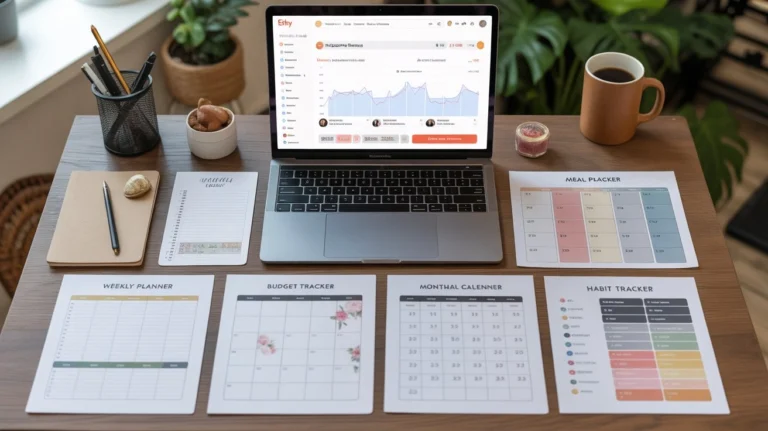How to Make Money Without a Job: 8 Proven Ways for Quick Cash & Freedom

Wondering how to make money without a job? You’re not alone. Many people feel stuck when bills pile up but a steady paycheck isn’t there. It’s stressful, and the thought of finding income without a boss or 9-to-5 can feel impossible.
Here’s the good news: it’s not only possible, it’s practical. From selling things you already own to offering simple services, freelancing online, or turning hobbies into side income, there are real ways to earn cash without traditional employment. This guide will walk you through step by step so you can start small, feel confident, and see money coming in.
1. Try Freelancing Online (Work From Anywhere)

Freelancing lets you earn money without a traditional job by selling skills on your own schedule. Common beginner-friendly services include writing, graphic design, video editing, social media posts, data entry, virtual assistance, translation, and tutoring. The fastest way to start is with a small niche (for example, “short product descriptions for Etsy shops” or “simple Instagram Reels edits”), because specific offers get picked more often than vague ones. Marketplaces like Upwork and Fiverr make it easy to create a profile, pitch small projects, and get paid safely through their escrow systems. UpworkFiverr Help Center
Set up a trust-building profile (and a tiny portfolio)
A clean profile photo, a one-sentence value statement (“I create clear product descriptions that boost sales”), and a short list of services help buyers decide quickly. Add 3–5 portfolio samples even if client work is new: make two or three practice samples that match your niche (e.g., redesign a flyer, write a mock blog intro, edit a 20-second clip) and label them “spec sample.” Platforms like Upwork’s beginner guide explain how strong profiles and targeted proposals raise your chances of getting hired; use their checklist as you set up. Upwork
Best practice: keep portfolio pieces short and scannable. For writing, 150–300 words with a headline and bullet benefits; for design, one image per sample plus a one-line outcome; for video, a 15–30 second clip. This makes it easy for busy buyers to click, skim, and say yes.
Pick a tiny niche first, then expand
Going narrow feels scary, but it helps the algorithm match you to buyers. Good beginner niches: “Podcast show notes,” “Canva social posts,” “Shopify product photos,” “YouTube Shorts captions,” or “Notion dashboard setup.” Once a few projects are complete, widen into related services (e.g., show notes → podcast audiograms; product photos → basic image retouching). This ladder approach keeps demand focused while growing income steadily.
Price smart: ladder up with clear packages
Start with three simple packages: Basic, Standard, Premium. Keep deliverables crystal clear (e.g., “3 Instagram posts + captions + 1 round of edits”). Price your Basic at an easy-yes level to win early reviews, then step up 10–20% every 3–5 completed orders with high ratings. Fiverr’s seller best practices recommend clear communication, defined revisions, and tracking performance—use these to reduce scope creep and protect your time. Fiverr Help Center
Write proposals that get replies (not ignored)
Clients skim. Use a three-part structure:
- First line: mirror their goal (“You need Amazon titles that rank and read naturally.”)
- Tiny proof: one sentence that shows you’ve done it (“I’ve optimized 120+ titles; average CTR +15%.”)
- Micro-plan + next step: 2–3 bullets on how you’ll do it, then ask one simple question (“Send three listings; I’ll rewrite a sample title today?”). Keep it under 120–150 words. Short + specific wins.
Protect yourself with contracts, milestones, and safe payments
When working off-platform, always use a written agreement and milestone payments. The Freelancers Union Contract Creator is a free, plain-English tool to set scope, deliverables, timelines, and payment terms. For payments, prefer platform escrow or invoice through trusted providers. PayPal Seller Protection can help on eligible transactions if you follow their rules; read the policy so you know what’s covered (e.g., unauthorized payments, item-not-received claims for eligible transactions). Freelancers Union+1PayPal+1
Safety tip: if a “client” asks you to pay a fee, buy software up front, or move to WhatsApp/Telegram immediately, walk away. The FTC warns that job and task scams often begin with surprise messages and pressure to pay to get paid—ignore and report. Consumer Advice+1
Communicate like a pro and keep clients coming back
Reply within business hours, confirm scope in writing, and recap calls in one short message (“Here’s what I’ll deliver by Friday…”). Share one quick progress update for multi-day projects to reduce check-in pings. Deliver on time with a tidy folder: main file, source file, and a brief “how to use” note. Close every project by asking for a specific follow-up (“Want me to schedule next month’s posts? Same package, delivered on the 28th.”). Small, repeatable retainers can turn one-off gigs into steady income.
Simple weekly routine to grow steadily
- 2 hours: send 5–8 targeted proposals (quality > quantity).
- 2 hours: upgrade one portfolio sample (or add a new one).
- 2 hours: learn one micro-skill (e.g., a Canva trick, a copy headline formula).
- Rest of time: deliver work and upsell logical add-ons (e.g., captions + thumbnails; blog post + meta title/description).
2. Turn Hobbies Into Income

Hobbies are powerful because you already enjoy them. The challenge is turning them into income. Here’s how to take what you love and make it profitable without a traditional job.
A: Identify the Right Hobby
Not every hobby will make money, but many can. Start by asking:
- Would someone pay for the product, service, or content this hobby creates?
- Can I deliver it consistently without losing interest?
Examples:
- Crafting → handmade products to sell.
- Fitness → personal training or digital content.
- Gaming → live streaming or guides.
- Photography → selling stock photos or offering local shoots.
B: Package It for Others
The key to making money is presenting your hobby in a way that others can use.
- If it’s a product hobby (crafts, baking, art): Sell through Etsy, local markets, or Facebook Marketplace. Start with small batches, track what sells fastest, and expand.
- If it’s a skill hobby (fitness, music, writing): Offer lessons, coaching, or digital tutorials. Use free platforms like YouTube or TikTok to build an audience while charging for one-on-one sessions.
- If it’s a content hobby (gaming, photography, blogging): Share consistently online. Monetization comes from ads, sponsorships, or affiliate links once you build trust and reach.
C: Market Your Hobby Smartly
No income flows without visibility. Here’s how to get eyes on your work:
- Post on social media (Instagram, TikTok, Pinterest) with behind-the-scenes and finished results.
- Join online communities related to your hobby — these are natural buyers.
- Offer free samples or small freebies at first to build trust and word-of-mouth.
- Use storytelling in your posts: people don’t just buy products, they buy the personal meaning behind them.
D: Price It Right
A common mistake is undercharging.
- Start by checking competitor prices.
- Price low enough to attract buyers but high enough to value your time.
- Over time, raise prices as you build quality and reviews.
- For content-based hobbies, remember income often starts small (ads or affiliate sales) but grows with consistency.
E: Scale Over Time
Once you see consistent results:
- Reinvent: Create variations of what sells best (e.g., a candle maker adds new scents).
- Automate: Use print-on-demand for designs, or stock photo sites for photography.
- Expand: Turn hobby income into a small business if you want — set up an online shop or offer bundled services.
👉 Example Flow:
A hobby baker starts by selling cupcakes to friends → lists on Facebook Marketplace → uses Instagram photos to attract buyers → eventually takes custom event orders. What started as “just baking” grows into $500–$1,000/month.
3.Use Gig Apps and Flexible Side Hustles

gig apps give you flexible ways to earn cash on your own schedule. These apps connect you directly with people who need quick services — from delivering food to assembling furniture.
Popular Gig Apps to Try
- Uber or Lyft – Earn money by driving passengers in your free time.
- DoorDash, Uber Eats, or Grubhub – Deliver meals from restaurants to customers.
- Instacart or Shipt – Shop for groceries and deliver them to busy families.
- TaskRabbit – Help with odd jobs like moving, assembling furniture, or yard work.
- Rover – Walk dogs or pet sit while owners are away.
All of these apps let you choose when you work and how much you work. That flexibility is what makes them attractive if you’re figuring out how to make money without a job.
Best Practices for Success
- Pick one app first – Don’t sign up for everything at once. Test one to see if it fits your lifestyle.
- Track your time and costs – Driving apps eat up gas; delivery apps take time. Write down how many hours you work, how much you earn, and what you spend. This helps you spot the most profitable gigs.
- Work peak times – For food delivery, evenings and weekends are best. For rideshare, late-night weekends can pay more, but weigh safety.
- Stack apps smartly – Some gig workers run multiple apps at once (e.g., DoorDash + Instacart) to fill downtime and maximize earnings.
- Stay safe – Meet in public areas, trust your gut, and avoid risky deliveries or rides if something feels off.
Why This Works
Gig apps are one of the fastest paths to cash because there’s no long setup time. As soon as you pass background checks and get approved, you can start working and get paid weekly (sometimes instantly with a small fee). For many people, this becomes their go-to bridge income — covering bills while building bigger plans like freelancing, digital products, or small businesses.
4. Try Microtasks and Online Surveys (Small but Steady Cash)
Maybe you don’t have a time or energy to drive for Uber or shop for groceries. If you’re looking for something lighter that you can do from home, microtasks and survey sites are a simple way to earn. The money is smaller than gig apps, but it can add up — especially if you use your downtime wisely.
What Are Microtasks?
Microtasks are small online jobs that don’t take long to finish. These can include:
- Identifying objects in photos (used for AI training)
- Testing apps or websites
- Simple data entry
- Writing short product reviews
- Watching ads or short videos
Websites like Amazon Mechanical Turk, Clickworker, Appen, and UserTesting pay for these tasks. While each task might only earn a few cents to a few dollars, doing several in a row can turn spare minutes into real money.
What About Online Surveys?
Survey sites connect you with brands that want your opinion. Popular ones include Swagbucks, Survey Junkie, and InboxDollars. You answer questions about shopping habits, products, or services and earn points or cash. Some also pay you for trying free trials, scanning receipts, or playing games.
Best Practices for Microtasks & Surveys
- Use trusted sites only – Stick to well-known platforms with solid reviews. Avoid sites that ask for upfront payment (that’s a red flag).
- Create a system – Dedicate a set time (like 30 minutes a day) to knock out tasks or surveys. Consistency builds results.
- Stack multiple sites – Sign up for a few platforms so when one runs out of surveys, you can switch to another.
- Cash out smart – Choose sites with flexible payouts (PayPal, gift cards, or direct deposit). Set a small cash-out goal to stay motivated.
- Think of it as extra, not main income – Microtasks won’t replace a full job, but they can cover small bills or become “bonus money” for savings goals.
Why It Fits With Gig Apps
Gig apps give you bigger chunks of income but require travel and energy. Microtasks and surveys fill the in-between moments — waiting in line, during TV breaks, or while commuting on the bus. This way, you can combine the two: make $50 delivering food on the weekend and another $20 doing surveys during the week. Small streams add up to meaningful amounts over time.
5. Build Passive Income for Long-Term Earnings
Once you’ve explored active methods like gig apps or microtasks, the next question is: How do I earn without trading time for money? That’s where passive income comes in. While “passive” doesn’t mean zero effort, it means setting systems that earn for you long after the initial work. Here are proven strategies that are working.
A. Create Digital Products That Sell While You Sleep

Digital products—like eBooks, courses, templates, or printables—are powerful because you create them once and sell them repeatedly. According to AWeber, these types of products offer excellent profit margins and require no inventory or shipping.
Popular choices:
- eBooks, workbooks, guides
- Canva or Notion templates
- Planners and printable organizers
- Design assets (social media templates, stock photos, icons)
Creators on Reddit love information products and creative templates best.
“My favorite products are information products (ebooks, guides, or video courses), or templates . . .” Reddit
Best practices:
- Pick a topic you’re good at (parenting routines, simple budgeting, study guides, etc.).
- Start with something small—like a one-page daily planner template.
- Sell using Etsy, Gumroad, or Shopify—no complicated setup needed.
- Promote via Instagram or a free PDF giveaway.
- Ask buyers for reviews or testimonials and update your product occasionally.
Many creators rave about this model. One creator made $120,000 in 9 months working just 5 hours per week. Business Insider
The key is to start simple and scale: bundle and create niche products as you go.
B. Affiliate Marketing: Earn from Recommendations
Affiliate marketing is another great option—share products you already love, and earn a small commission when someone buys through your link. Platforms like Amazon Associates, ShareASale, and niche company programs are easy to join.
Why it works:
- You don’t need to create anything.
- Perfect if you have a blog, TikTok, or Instagram with followers.
- Honest reviews of the things you use most can build trust and clicks.
Pro tip: Share honest tips or comparisons (e.g., “Best budget planners under $10”), link to products, and pair them with a free resource to drive both value and clicks.
Passive income isn’t about instant riches—it’s about slowly growing streams that support freedom, creativity, and financial ease. It works especially well when paired with a growing habit of earning consistently.
RELATED: 10 Best Side Hustles for Moms.
6. Rent Out What You Already Own
One of the smartest ways to make money without a job is to earn from things you already own. Instead of letting spare rooms, cars, or tools sit unused, you can rent them out to people who need them. This turns everyday items into money-making assets and often requires less effort than active side hustles.
A. Rent Your Home or Extra Space
Platforms like Airbnb and Vrbo allow you to rent out a spare room, basement, or even your entire house. Hosts often earn anywhere from a few hundred to several thousand dollars a month, depending on location. Success comes down to:
- Taking professional-style photos (bright, clear images sell faster).
- Writing honest, detailed descriptions of your space.
- Keeping it clean and adding small touches like fresh towels or Wi-Fi access.
Even if you don’t live in a tourist area, short-term stays are in demand for visiting families, students, or business travellers.
B. Rent Your Car or Parking Spot
Your vehicle could be a passive income stream. Apps like Turo let you rent out your car when it’s not in use. In busy cities, you can also rent out parking spaces to commuters or apartment dwellers.
Best practices:
- Keep the car maintained and insured.
- Use the platform’s coverage options for extra protection.
- Set reasonable mileage and usage rules.
C. Rent Tools, Equipment, or Gear
From power tools to cameras, drones, or even musical instruments, people often prefer to rent instead of buying. Apps like Fat Llama make this simple, while local community boards are great for bigger tools like lawnmowers.
- Take photos before and after rentals.
- Keep a written agreement or use the platform’s contract system.
- Offer weekend or bundle discounts to encourage longer rentals.
D. Creative Rentals People Forget About
- Party supplies (chairs, tables, decor).
- Sports gear (bikes, skis, camping equipment).
- Event spaces (a backyard or garage for small events).
These overlooked rentals can bring in extra income with minimal extra work.
Why This Works
Renting what you own is one of the most sustainable income streams because you don’t need to buy new inventory. It’s also scalable: start small by renting a single tool or parking spot, then expand into multiple listings across different categories. Over time, these earnings can cover monthly bills, grow your savings, or support bigger financial goals like the Zero-Based Budget where every dollar is put to work.
6. Sell Items You Already Own

The fastest way to make money without a job is to look around your home. Chances are, you already have things lying around that you no longer use but someone else would gladly pay for. Old phones, unused kitchen gadgets, extra furniture, or even clothes that don’t fit anymore can all be turned into quick cash.
Here’s how it works: pick a few items in good condition, clean them up, and take clear photos. Then, list them on platforms like Facebook Marketplace, eBay, OfferUp, or Craigslist. Write simple but honest descriptions, set fair prices, and respond quickly to interested buyers. Everyday essentials — like furniture, electronics, and kids’ items — often sell the fastest.
This method is perfect if you need money urgently because you don’t have to buy or create anything new. It also gives you a fresh start by decluttering your space. To make it even more effective, focus on items that people need right now — like seasonal gear or home essentials. Over time, this can even turn into a small side hustle if you start flipping items you find cheaply and resell them for profit.
RELATED READ: How to Make Money Selling on Facebook Marketplace, Step-by-Step Guide.
8. Offer Local Services Without a Traditional Job
If you want to know how to make money without a job, one of the simplest answers is to offer services in your local area. Many people are willing to pay for help with everyday tasks, and you don’t need special qualifications to get started. Think about jobs that save others time: mowing lawns, babysitting, dog walking, house cleaning, or even running errands for busy neighbours.
These services are in demand because they solve real problems. Parents need a trusted sitter, pet owners want someone reliable to care for their dogs, and homeowners appreciate help with yard work. You can start by offering services to friends, family, or neighbours and then expand by posting flyers, sharing on local Facebook groups, or listing yourself on apps like TaskRabbit or Care.com.
The best part is flexibility — you decide when and how often you work. It can start small, like walking a neighbor’s dog once a week, and grow into steady income if you’re consistent. Not only does this bring in cash, but it also builds trust and repeat clients. Over time, these “little jobs” can feel like your own business, giving you freedom that a 9-to-5 job doesn’t.
Conclusion
Making money without a job is not just a dream — it’s possible with today’s tools and opportunities. From selling unused items to gig apps, freelancing, and turning hobbies into profitable ventures, there are paths for both quick cash and long-term stability.
The important part is to start small and stay consistent. Pick one method that feels doable today, whether that’s listing an item online or signing up for a gig app. As you see results, expand into more streams — this way, you won’t rely on just one source.
Remember: every extra dollar counts. Whether you need $100 today or a plan to build $1,000 a week, the strategies in this guide give you a starting point. With patience and persistence, making money without a job can go from a short-term fix to a lifestyle that gives you freedom, flexibility, and control over your future.






